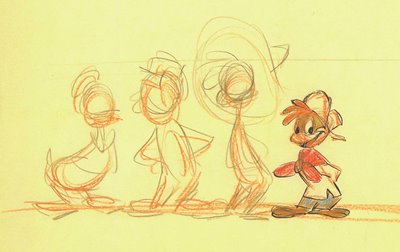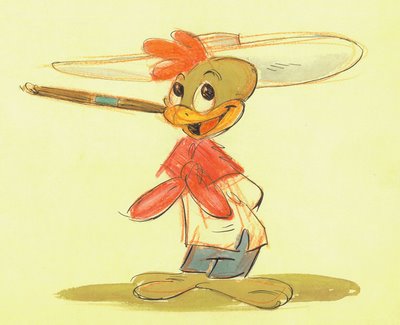




All these can be clicked and enlarged
I'd love to have more information on these designs of a "Littler Panchito"; I've read brief mentions here and there of a proposed sequel to "Three Caballeros" which was never made, and that must be what these were for, but how long was this worked on? Exactly when? When and why was it shelved? Did it get into boards at all? If the questions are answered somewhere(for instance, in Charles Solomon's "The Disney That Never Was"), unfortuately it's among the several hundred volumes I still haven't unpacked at home. Anyone who's got that helpful info off the top of their heads, feel free to comment!
Typically great, fun, appealing Moore designs. A scan of a ascan doesn't do them total justice, but it gives you a pretty good idea of how vibrant the originals are.
I think it's too bad Fred wasn't on that 1941 junket to South America, by the way; imagine what he could have done, sketching from the local sights.





17 comments:
Love the colours of these. Very cute...Classic Disney...so great!
Love your blog
Yes, as Marc Davis said: "God! Fred Moore was Disney drawing!" And he was so right. : )
Thanks for the nice comments!
Amazing stuff, thanks for posting.
Absolutely gorgeous and humbling...
When abouts was Freddy proposing to make this? It could have been shelved after his untimely death.
Mark--darn it! I'm sorry I missed you.
Jim M-you said it!
David-I'm pretty sure this was planned and done before 1946--and discarded before then too.
Fred was dismissed from Disney in 1946, and rehired in '48; he died in 1952. At the time he died he wasn't doing any visual development like this, but was an animator doing mainly short scenes in the features and shorts.
When he did these drawings, he was still near the top of his game at Disney's.
Gawwwwwwwwwwwwwwwwww.
Beautiful.
B
Careful Jenny. I am getting addicted and what you give us to enjoy is stronger and stronger everyday!
Didier
oh, i love these! they seem to predate the "Baby Disney" concept by about a half century :)
and i don't think i've ever seen anything about a Caballeros sequel...time to check with the Disney Archives!
PS: I also see you have the same problem with your profile slipping to the bottom of the page. Haven't been able to figure out how to move it back up again :(
There's so much energy in these roughs; I love it. I'll bet his PT's were interesting to see. Too bad his work had to go through the completion process.
That's right about Frank Thomas. It was Frank who gave me a stack of Fred Moore original animation. It was awesome!
Good stuff. Thanks, Jenny.
So much inspiring stuff in your blog. Those roughs are amazing..
Thanks for posting these! They're terrific.
Not for nothing was Kimball sometimes known as "the velvet knife"...
Post a Comment